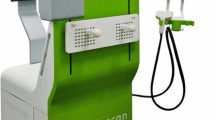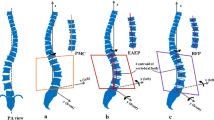Abstract
Purpose
Clinical ultrasound is radiation-free, low cost and user friendly, which makes it probable in assessment of scoliosis. Numerous studies have been conducted about the feasibility of using clinical ultrasound to assess scoliosis; thus, an inclusive review of the literature would be beneficial for researchers, clinicians and patients. This study aimed to systematically review the reliability and validity of coronal curvature assessments obtained from different clinical ultrasound imaging methods.
Methods
A comprehensive search of 6 databases and Google Scholar search engine was performed for retrieving articles assessing reliability and/or validity of spinal curvature measurements obtained from clinical ultrasound. Two reviewers assessed the methodological quality of selected articles independently using criteria appraisal instrument. The results were analysed and synthesized qualitatively using level of evidence method.
Results
Fourteen articles were included. Thirteen articles investigated both the reliability and validity, of which nine were of high quality; and one article evaluated only the reliability and was of high quality. Totally five ultrasound methods were evaluated. Very high reliability (intra-class correlation coefficient = 0.80–1.00) but limited levels of evidence were found for the majority of the studied ultrasound methods. Almost all the methods showed good to excellent validity (correlation coefficient = 0.76–1.00) but limited to moderate levels of evidence.
Conclusion
A high level of evidence was found in support of the reliability and validity of the COL (centre of lamina) ultrasound method. Further reliability and validity studies should be conducted to strengthen the level of evidence for those ultrasound methods with moderate, limited or conflicting level of evidence.
Graphic abstract
These slides can be retrieved under Electronic Supplementary Material.


Similar content being viewed by others
References
Konieczny MR, Senyurt H, Krauspe R (2013) Epidemiology of adolescent idiopathic scoliosis. J Child Orthop 7(1):3–9. https://doi.org/10.1007/s11832-012-0457-4
Lonner B, Yoo A, Terran JS, Sponseller P, Samdani A, Betz R, Shuffelbarger H, Shah H, Newton P (2013) Effect of spinal deformity on adolescent quality of life: comparison of operative scheuermann kyphosis, adolescent idiopathic scoliosis, and normal controls. Spine 38(12):1049–1055. https://doi.org/10.1097/BRS.0b013e3182893c01
Choudhry MN, Ahmad Z, Verma R (2016) Adolescent idiopathic scoliosis. Open Orthop J 10:143–154. https://doi.org/10.2174/1874325001610010143
Johnston CE, Richards BS, Sucato DJ, Bridwell KH, Lenke LG, Erickson M (2011) Correlation of preoperative deformity magnitude and pulmonary function tests in adolescent idiopathic scoliosis. Spine 36(14):1096–1102. https://doi.org/10.1097/BRS.0b013e3181f8c931
Koumbourlis AC (2006) Scoliosis and the respiratory system. Paediatr Respir Rev 7(2):152–160. https://doi.org/10.1016/j.prrv.2006.04.009
Martinez-Llorens J, Ramirez M, Colomina MJ, Bago J, Molina A, Caceres E, Gea J (2010) Muscle dysfunction and exercise limitation in adolescent idiopathic scoliosis. Eur Respir J 36(2):393–400. https://doi.org/10.1183/09031936.00025509
Ronckers CM, Land CE, Miller JS, Stovall M, Lonstein JE, Doody MM (2010) Cancer mortality among women frequently exposed to radiographic examinations for spinal disorders. Radiat Res 174(1):83–90
Knott P, Pappo E, Cameron M, deMauroy JC, Rivard C, Kotwicki T, Zaina F, Wynne J, Stikeleather Luke, Bettany-Saltikov J, Grivas TB, Durmala J, Maruyama T, Negrini S, O’Brien JP, Rigo M (2014) SOSORT 2012 consensus paper: reducing x-ray exposure in pediatric patients with scoliosis. Scoliosis 9(1):4
Cheung CWJ, Law SY, Zheng YP Development of 3-D ultrasound system for assessment of adolescent idiopathic scoliosis (AIS): and system validation. In: 35th annual international conference of the IEEE EMBS, Osaka, Japan, 2013
Hsu PW, Prager RW, Gee AH, Treece GM (2006) Rapid, easy and reliable calibration for freehand 3D ultrasound. Ultrasound Med Biol 32(6):823–835. https://doi.org/10.1016/j.ultrasmedbio.2006.02.1427
Koo TK, Guo JY, Ippolito C, Bedle JC (2014) Assessment of scoliotic deformity using spinous processes: comparison of different analysis methods of an ultrasonographic system. J Manip Physiol Ther 37(9):667–677. https://doi.org/10.1016/j.jmpt.2014.09.007
Solomon E, Shortland AP, Meyer AK, Lucas JD (2016) The development and validation of a 3D ultrasound system for monitoring curve progression of patients with scoliosis. Spine J 16(4):S51–S52. https://doi.org/10.1016/j.spinee.2016.01.043
Zhou GQ, Zheng YP Assessment of scoliosis using 3-D ultrasound volume projection imaging with automatic spine curvature detection. In: IEEE international ultrasonics symposium, 2015
Zhou GQ, Jiang WW, Lai KL, Zheng YP (2017) Automatic measurement of spine curvature on 3-D ultrasound volume projection image with phase features. IEEE T on Med Imaging 36(6):1250–1262
Vo QN, Lou EHM, Le LH (2015) Reconstruction of a scoliotic spine using a three-dimensional medical ultrasound system. Scoliosis 10(S1):P17. https://doi.org/10.1186/1748-7161-10-s1-p17
Chen W, Lou E, Le LH (2015) A reliable semi-automatic program to measure the vertebral rotation using the center of lamina for adolescent idiopathic scoliosis. In: In: 5th international conference on biomedical engineering in Vietnam. IFMBE Proceedings, pp 159–162. https://doi.org/10.1007/978-3-319-11776-8_39
Cheung CWJ, Zhou GQ, Law SY, Mak TM, Lai KL, Zheng YP (2015) Ultrasound volume projection imaging for assessment of scoliosis. IEEE T Med Imaging 34(8):1760–1768
Nguyen DV, Vo QN, Le LH, Lou EH (2015) Validation of 3D surface reconstruction of vertebrae and spinal column using 3D ultrasound data—a pilot study. Med Eng Phys 37(2):239–244. https://doi.org/10.1016/j.medengphy.2014.11.007
Li M, Ng B, Cheng J, Ying M, Zheng YP, Lam TP, Wong WY, Wong MS (2012) Could clinical ultrasound improve the fitting of spinal orthosis for the patients with AIS? Eur Spine J 21:1926–1935
Zheng R, Young M, Hill D, Le LH, Hedden D, Moreau M, Mahood J, Southon S, Lou E (2016) Improvement on the accuracy and reliability of ultrasound coronal curvature measurement on adolescent idiopathic scoliosis with the aid of previous radiographs. Spine 41(5):404–411
Zheng R, Chan AC, Chen W, Hill DL, Le LH, Hedden D, Moreau M, Mahood J, Southon S, Lou E (2015) Intra- and inter-rater reliability of coronal curvature measurement for adolescent idiopathic scoliosis using ultrasonic imaging method—a pilot study. Spine Deform 3(2):151–158. https://doi.org/10.1016/j.jspd.2014.08.008
Khodaei M, Hill D, Zheng R, Le LH, Lou EHM (2018) Intra- and inter-rater reliability of spinal flexibility measurements using ultrasonic (US) images for non-surgical candidates with adolescent Idiopathic scoliosis: a pilot study. Eur Spine J 27(9):2156–2164. https://doi.org/10.1007/s00586-018-5546-8
Zheng R, Hill D, Hedden D, Moreau M, Southon S, Lou E (2018) Assessment of curve progression on children with idiopathic scoliosis using ultrasound imaging method. Eur Spine J 27(5):1–6. https://doi.org/10.1007/s00586-017-5457-0
Brink RC, Wijdicks SPJ, Tromp IN, Schlosser TPC, Kruyt MC, Beek FJA, Castelein RM (2018) A reliability and validity study for different coronal angles using ultrasound imaging in adolescent idiopathic scoliosis. Spine J 18(6):979–985. https://doi.org/10.1016/j.spinee.2017.10.012
Zheng YP, Lee TTY, Lai KKL, Yip BHK, Zhou GQ, Jiang WW, Cheung JCW, Wong MS, Ng BKW, Cheng JCY, Lam TP (2016) A reliability and validity study for Scolioscan: a radiation-free scoliosis assessment system using 3D ultrasound imaging. Scoliosis 11:13
Wang Q, Li M, Lou EHM, Wong MS (2015) Reliability and validity study of clinical ultrasound imaging on lateral curvature of adolescent idiopathic scoliosis. PLoS ONE 10(8):e0135264
Young M, Hill DL, Zheng R, Lou E (2015) Reliability and accuracy of ultrasound measurements with and without the aid of previous radiographs in adolescent idiopathic scoliosis (AIS). Eur Spine J 24(7):1427–1433. https://doi.org/10.1007/s00586-015-3855-8
Cheung CWJ, Zhou GQ, Law SY, Lai KL, Jiang WW, Zheng YP (2015) Freehand three-dimensional ultrasound system for assessment of scoliosis. J Orthop Transl 3:123–133
Li M, Cheng J, Ying M, Ng B, Lam TP, Wong MS (2015) A preliminary study of estimation of Cobb’s angle from the spinous process angle using a clinical ultrasound method. Spine Deform 3:476–482
Lohr K (2002) Assessing health status and quality-of-life instruments attributes and review criteria. Qual Life Res 11(3):193
Terwee CB, Bot SD, Boer MRd, van der Windt DA, Knol DL, Dekker J, Bouter LM, Vet HCd (2007) Quality criteria were proposed for measurement properties of health status questionnaires. J Clin Epidemiol 60(1):34–42. https://doi.org/10.1016/j.jclinepi.2006.03.012
Brink Y, Louw QA (2012) Clinical instruments: reliability and validity critical appraisal. J Eval Clin Pract 18(6):1126–1132. https://doi.org/10.1111/j.1365-2753.2011.01707.x
Barrett E, McCreesh K, Lewis J (2014) Reliability and validity of non-radiographic methods of thoracic kyphosis measurement: a systematic review. Man Ther 19(1):10–17. https://doi.org/10.1016/j.math.2013.09.003
Stephen M, Ken CL, Chris L, Dave L, Mahmoud S (2010) Reliability of physical examination tests used in the assessment of patients with shoulder problems: a systematic review. Physiotherapy 96(3):179–190. https://doi.org/10.1016/j.physio.2009.12.002
Adhia DB, Bussey MD, Ribeiro DC, Tumilty S, Milosavljevic S (2013) Validity and reliability of palpation-digitization for non-invasive kinematic measurement—a systematic review. Man Ther 18(1):26–34. https://doi.org/10.1016/j.math.2012.06.004
van Tulder M, Furlan A, Bombardier C, Bouter L (2003) Updated method guidelines for systematic reviews in the cochrane collaboration back review Group. Spine 28(12):1290–1299
Currier DP (1984) Elements of research in physical therapy, 3rd edn. William and Wikins, Baltimore
Dawson B, Trapp RG (2004) Basic and clinical biostatistics, 4th edn. Lange Medical Books/McGraw-Hill, New York
Liberati A, Altman DG, Tetzlaff J, Mulrow C, Gotzsche PC, Ioannidis JP, Clarke M, Devereaux PJ, Kleijnen J, Moher D (2009) The PRISMA statement for reporting systematic reviews and meta-analyses of studies that evaluate health care interventions: explanation and elaboration. PLoS Med 6(7):e1000100. https://doi.org/10.1371/journal.pmed.1000100
Trac S, Zheng R, Hill DL, Lou E (2019) Intra- and interrater reliability of Cobb angle measurements on the plane of maximum curvature using ultrasound imaging method. Spine Deform 7(1):18–26. https://doi.org/10.1016/j.jspd.2018.06.015
Lv P, Chen J, Dong L, Wang L, Deng Y, Li K, Huang X, Zhang C (2019) Evaluation of scoliosis with a commercially available ultrasound system. J Ultras Med 9999:1–8. https://doi.org/10.1002/jum.15068
Zheng R, Hill D, Hedden D, Mahood J, Moreau M, Southon S, Lou E (2018) Factors influencing spinal curvature measurements on ultrasound images for children with adolescent idiopathic scoliosis (AIS). PLoS ONE 13(6):e0198792. https://doi.org/10.1371/journal.pone.0198792
Brink Y, Louw Q (2012) Clinical instruments: reliability and validity critical appraisal. J Eval Clin Pract 18:1126–1132
Shi B, Mao S, Wang Z, Lam TP, Yu FWP, Ng BKW, Chu WC-W, Zhu Z, Qiu Y, Cheng JCY (2015) How does the supine MRI correlate with standing radiographs of different curve severity in adolescent idiopathic scoliosis? Spine 40(15):1206–1212. https://doi.org/10.1097/brs.0000000000000927
Hui SC, Pialasse JP, Wong JY, Lam TP, Ng BK, Cheng JC, Chu WC (2016) Radiation dose of digital radiography (DR) versus micro-dose x-ray (EOS) on patients with adolescent idiopathic scoliosis: 2016 SOSORT- IRSSD “John Sevastic Award” Winner in Imaging Research. Scoli Spinal Disord 11:46. https://doi.org/10.1186/s13013-016-0106-7
Frerich JM, Hertzler K, Knott P, Mardjetko S (2012) Comparison of radiographic and surface topography measurements in adolescents with idiopathic scoliosis. Open Ortho J 6:261–265
Wu H, Ronsky JL, Cheriet F, Harder J, Kupper JC, Zernicke RF (2011) Time series spinal radiographs as prognostic factors for scoliosis and progression of spinal deformities. Eur Spine J 20(1):112–117. https://doi.org/10.1007/s00586-010-1512-9
Funding
No funds were received in support of this work.
Author information
Authors and Affiliations
Corresponding author
Ethics declarations
Conflict of interest
Hui-Dong Wu, Wei Liu and Man-Sang Wong declared not having any conflict of interest.
Additional information
Publisher's Note
Springer Nature remains neutral with regard to jurisdictional claims in published maps and institutional affiliations.
Electronic supplementary material
Below is the link to the electronic supplementary material.
Rights and permissions
About this article
Cite this article
Wu, HD., Liu, W. & Wong, MS. Reliability and validity of lateral curvature assessments using clinical ultrasound for the patients with scoliosis: a systematic review. Eur Spine J 29, 717–725 (2020). https://doi.org/10.1007/s00586-019-06280-y
Received:
Revised:
Accepted:
Published:
Issue Date:
DOI: https://doi.org/10.1007/s00586-019-06280-y




